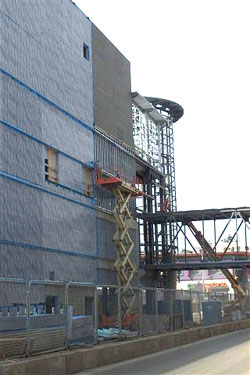Difference between Air Barriers, Vapour Barriers & Water Resistive Barriers

Air barriers are not to be confused with vapour barriers or water resistive barriers. Each barrier have a different function to perform in a building assembly.
Vapour barriers are materials used to slow or reduce the movement of water vapour through a material (water vapour is also transported by air leakage but this can be resolved by installing an air barrier). Vapour barrier materials are installed on the warm side of the insulation in a building assembly. The position of the vapour barrier in a building assembly will be determined based on the climatic conditions. It warm climates, it will be on the exterior and in cold climates, it will be on the interior.
A vapour barrier can be a mechanically fastened sheet-material, self-adhered membranes (depending on composition), fluid-applied materials, insulating boardstock or medium density spray polyurethane foam. The thickness of the material will impact whether it is a vapour barrier or not.
Water vapour transmission is the measurement of water vapour through a material. In most cases, the results are expressed as vapour permeance. The most common test method for measuring water vapour permeance is ASTM E96. You can test using either the desiccant and water method and is typically the results are reported in the units of ng/(Pa*s* m2) or US Perms. The test measures the water vapour that passes through a material. Proper specimen preparation is critical and experience has shown that if there are pinholes in the material or if the specimen has not been properly sealed into the apparatus using the correct mixture of wax, the results are not repeatable or reproducible.
Check the ABAA website for the water vapour permeance listings of all air barrier materials
Water resistive barriers are materials on the exterior of a building which are intended to resist liquid (bulk) water that has leaked, penetrated or seeped past the exterior cladding from absorbing into the exterior sheathing or concrete wall (depending on the application) and further into the wall assembly. Water resistive barrier materials can be mechanically fastened building wraps, fluid applied membranes, cellular plastic, self adhered, building paper or any other material that has been designed to resist liquid water. Water resistive barriers are combined with flashing and other supporting materials to ensure that there is a shingled effect to direct liquid water away from the exterior sheathing.
Testing the water resistance of a material is normally done using the boat method (ASTM D779), the "water ponding" method (CCMC 07102 section 6.4.5) or the hydrostatic head method (AATCC 127)
Air barrier materials are materials that are used anywhere in a building assembly to stop the movement of air into or out of the conditioned space (water vapour can also be transported by air). Air barriers can be mechanically fastened building wraps, self-adhered membranes, fluid-applied materials, insulating boardstock, non-insulating boardstock, spray polyurethane foam, poured concrete, metal, glass, and a host of other materials.
Air permeance is the amount of air that permeates through a material, whereas air leakage is the air that passes through holes or gaps. Any material that has a air permeance that is not greater than 0.02 L/(s • m2) at a pressure difference of 75 Pa (0.004 cfm/ft2 at a pressure difference of 1.56 lb/ft2) when tested in accordance with ASTM E 2178 or CAN/ULC-S741 is a air barrier material.
Click here to see the list of all ABAA evaluated materials
Multiple function materials
Materials can provide a air barrier function, a vapour barrier function or a water resistive barrier function or any combination of these three functions. Some materials can provide all three of these functions plus the function of a thermal insulation. Other materials may provide all three functions and some materials may provide two functions. It would be unusual for a material to only provide one function.
There are materials that are water resistive barriers but not air barriers and materials that are water resistive barriers that are air barriers. There are materials that are air barriers and are also vapour barriers and there are materials that are air barriers but are not vapour barriers. There are water resistive barriers that are also vapour barriers and there are materials that are water resistive barriers that are not vapour barriers. The design professional needs to understand the properties of the materials to use them correctly in a building assembly.
You need to understand the separate functions that the materials may provide and then determine whether the specific material you choose provides more than one function. Then you need to determine whether you want that specific material is to provide more than one function. You will have multiple materials that can provide the air barrier function. You need to designate the material as providing the air control layer and use air barrier accessory materials to seal all the joints and penetrations before it becomes an air barrier assembly which is then incorporated into the air barrier system.
